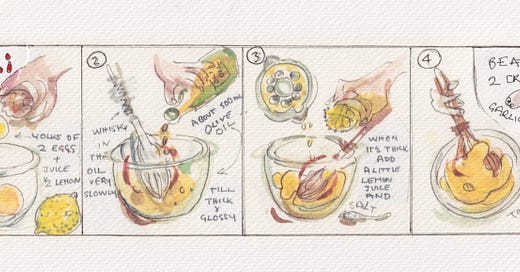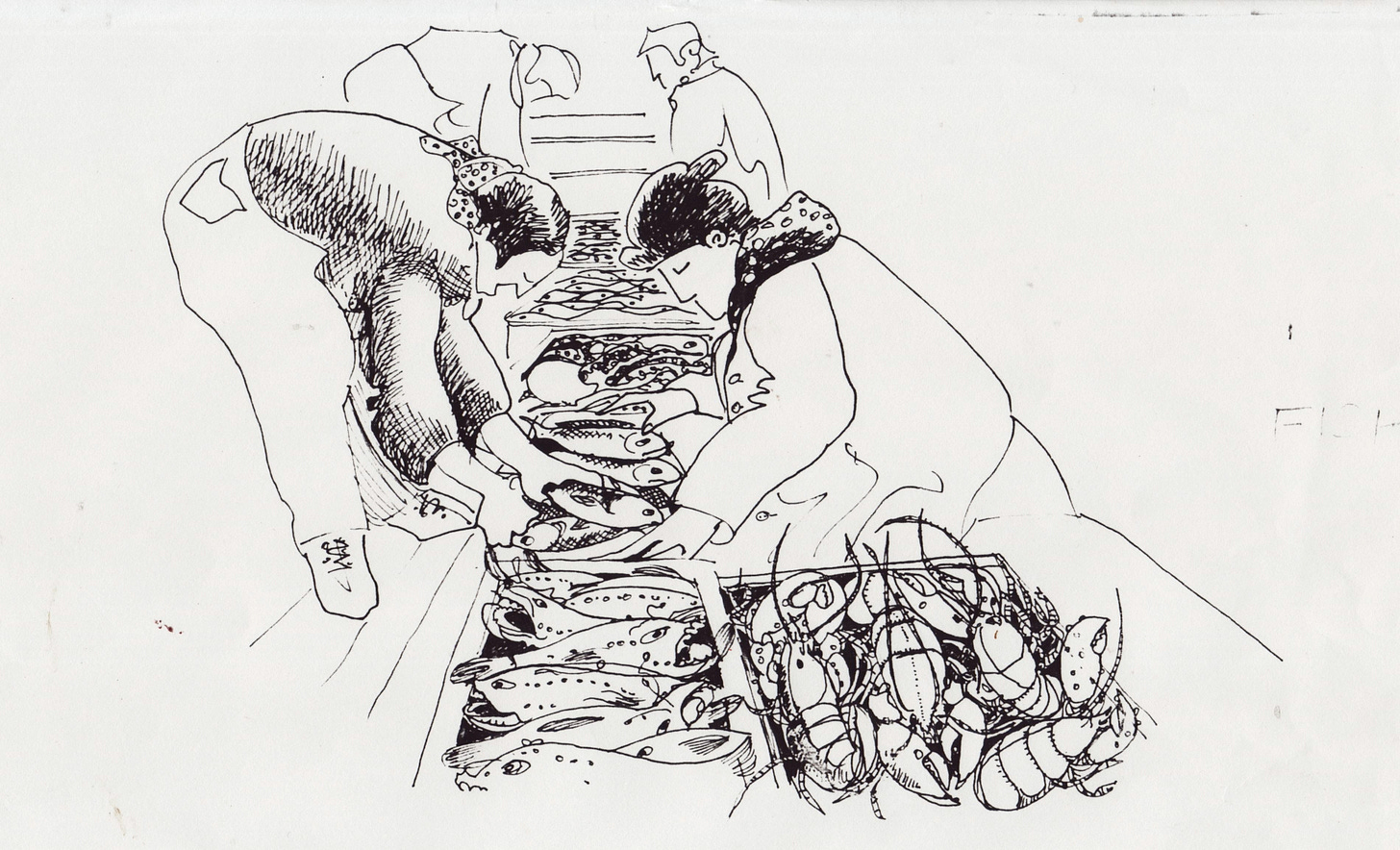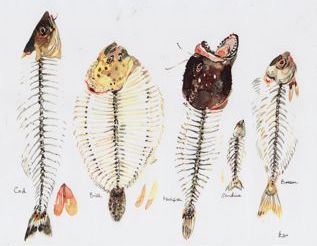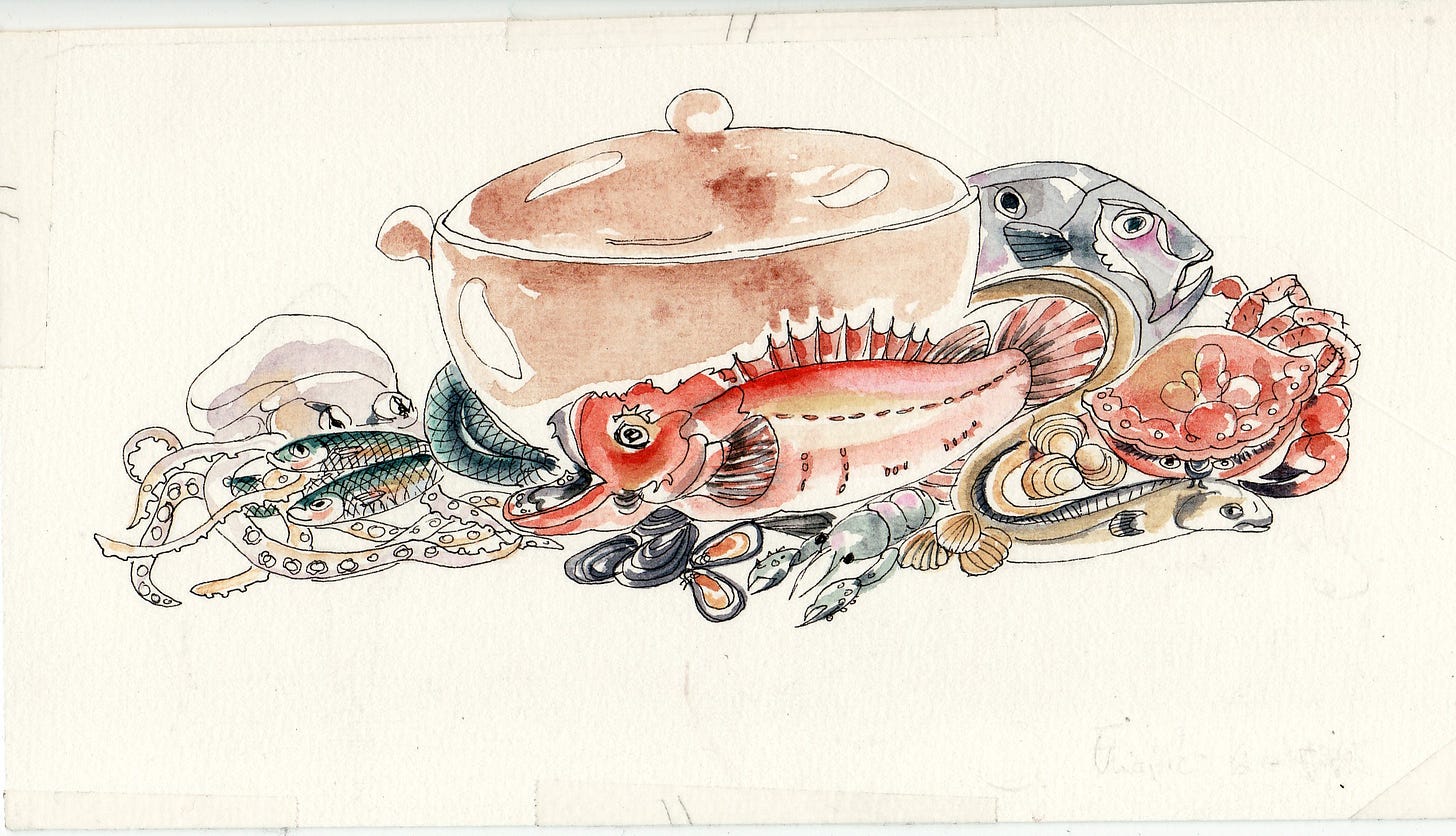Aioli, in spite of its modern incarnation as a garlicky mayonnaise (as above), is - was - in its original form, it’s a simple emusification of olive oil and garlic cloves crushed salt (no egg-yolk) that serves as a stirring-sauce to flavour and finish anything that needs a little encouragement, particularly anything soupy involving fish.
In theory, and possibly in reality, Marseilles is the home of the mighty bouillabaisse, mother-and-father of all fish soups. Which is not the same as soupe de poisson since it’s served as the star of the show and appears as more than one course - two or possibly three.
Ingredients and technique differ from other fish soups in that the basis is a ready-made broth prepared with the fisherman’s by-blows - small soup=fish, heads, bones and whatever hasn’t sold at the end of the day on the quay-side. Technique, bouillon-a-baisse - refers to the process of raising and lowering the heat under the pot to create an emulsion to thicken the broth.
The bouillabaisse, in other words, is no ordinary soupe-de-poisson. It’s not, for instance, New England's chowder, which includes bacon and cream, and has its origins in Brittany's chaudiere, an all-in cook-up in a cauldron on shipboard that may or may not include the less saleable parts of the catch. Nor is it the same as the Greek fish-soup that that's finished with a velvety avgolemono, a thickening of egg and lemon. There is also, it so happens, a bouillabaisse borne - one-eyed fish-soup - that's prepared with the broth alone, maybe with a poached egg and a handful of greens, on days when the inshore fleet hasn’t put to sea, or the nets were hauled up empty.
Since the Mediterranean is not tidal, her inshore fishing fleet lands the catch at the same time every day just in time for supper. The result is a local market knowledgeable enough to scoop up the fisherman’s by-blows and make the best of what might otherwise been wasted, leaving the high-value catch - tuna, swordfish, bonito - to the dealers who meet the boats as soon as they dock with refridgerated vans, and sell everything internationally.
Availability of raw materials and good housekeeping is the reason for the daunting number of species included in a bouillabaise. A reason, too, for its elevation to star of the show when served in two or even three courses rather than as a starter for something more substantial, as happens with an everyday soupe-de-poisson.
As for choice of fish, flexibility is possible, but certain things are generally agreed. For strength in the broth, there must be one or more rockfish - spiny creatures with gluey bones as found in rockpools around the tidal zone. Rascasse is usual, but there is also rouquier, labre, girelle and demoiselle. In addition, anything labelled soup-fish (including heads and bones) is acceptable, with the exception of sardines, anchovies and members of the flatfish family such as sole and turbot, any of which will turn the broth bitter. Shellfish are never included, lobster and crab are possible, saffron is the only essential flavouring, five is the minimum number of species, and seven is the minimum number of participants - any fewer and you won’t be able to include a sufficient variety of fish.
Bouillabasse
The most fiendishly complicated of all fish soups was invented, legend has it, by the fishwives of Marseilles who prepared the basic fish-broth with whatever hadn’t sold that day, alongside the day’s catch. The name comes from the method of cooking - bouillon-abaissé - a broth whose heat is raised and lowered and then raised again, producing an emulsion in pre-liquidiser days. As for choice of fish, latidude is allowed - the recipe is not set in stone. Nevertheless, certain things are generally agreed. Shellfish - oysters, clams, scallops and the like - are never included. Nor are the clupidae - sardines, anchovies, herrings, mackerel - or members of the flatfish family, any of which can turn the broth bitter. For strength in the broth, there must be one or more of the rockfish - in France, these are rascasse, rouquier, labre, girelle, demoiselle. Olive oil is the non-negotiable enrichment, saffron the only essential flavouring, and seven is the minimum number for which it’s proper to prepare it. So said the great nineteenth century authority on Provençal cooking, Jean-Baptiste Reboule, friend and contempory of the guru of the Languedoc, Frederic Mistral. ‘Nuff said.
Serves 6-8
For the fish, allow 4-5k, scaled and cleaned
Rockfish of the wrasse family (rascasse) (US: tautog, blackfish, cunner)
Sea bass (loup de mer)
Monk-fish (baudroie)
Scorpion fish (chapon) (US: Blue Mouth, Ocean Perch, Redfish)
John Dory (saint-pierre)
Conger-eel
Red mullet (rouger) (US: goatfish)
Red gurnard (galinette) (US: sea-robin)
Whiting (merlan) (US: blue whiting, cusk, white/squirrel hake)
Weever fish(vive) (US: scabbard fish)
Spiny lobster (langouste) also known as crawfish, rock lobster) (US: slipper- or flat-lobster, mantis-shrimp)
Shore crabs: stone, rock, green, blue, oyster or pea crab and red crab.
Prawns, crayfish, shrimp (langoustine, cigalle, crevette)
Skate (raie)
The basic broth
Bones, heads, trimmings from the above, including whole fish if small
3-4 shallots or leeks, trimmed and chopped
3-4 garlic cloves, crushed
2 large tomatoes, scalded, skinned, de-seeded and chopped
3-4 sprigs each fennel, parsley, thyme
A curl of dried orange peel
About 12 saffron threads
3-4 large, oval, yellow-fleshed potatoes, peeled and quartered horizontally
Pepper and salt
For the Rouille
4 garlic cloves
1/2 teaspoon salt
2 red chillies, de-seeded and chopped
2 red peppers, whole (or ready-prepared, canned)
1 thick slice dry bread (about 50g/2oz)
To finish
About 8 tablespoons olive oil
4 dried-out bread-rolls, sliced in half (in Marseilles, navette a soupe)
Scale, trim and bone the fish as appropriate, reserving the heads and skeletons. Cut the larger fish into pieces roughly the same size as the smaller fish.
Divide the fish between 2 plates. Plate no.1 should have firm fleshed fish - rascasse, weaver, gurnard, eel, monkfish, swordfish and anything else that feels firm to the finger including any crustaceans. Plate no. 2 should have the soft-fleshed fish: sea bass, wrasse, St. Peter's fish, whiting and whatever else you have that looks like a member of the group.
Put the fish debris, shallots or leeks, chopped tomato, herbs, orange zest and saffron in your chosen boiling-bot with 4 litres/8 pints water. Bring to the boil, season with salt and pepper, turn down the heat and simmer for 20-30 minutes to extract all the flavour and body. Strain the broth and return it to the pot with the potatoes. Bring all back to the boil.
Meanwhile, make the rouille. Crush the garlic with the salt. Burn off the skin of the peppers by roasting them in a very hot oven (450F/230C/Gas8) for about 15 minutes, or burn them over a direct flame till the skin is charred, pop them in a plastic bag to soften for 20 minutes, then the flesh from the skin with a knife. Soak the bread in a little water and squeeze it dry. Pound all the ingredients together into a smooth paste in the processor or with a pestle and mortar. Reserve.
Set a soup tureen and a large serving dish to warm along with sufficient soup-plates for all, and warn participants you’ll be ready in exactly 10 minutes (as with the soufflé, bouillabaisse waits for no man).
As soon as the broth and potatoes have come back to the boil, allow 10 minutes for the potatoes to soften a little. Add the firm-fleshed fish from plate no. 1, starting with the crustaceans. Sprinkle with the olive oil, cover the pot again and bring all swiftly back to the boil.
Boil rapidly for 5 minutes. Lay in the soft fish from plate no. 2. Bring all swiftly back to the boil and continue boiling briskly, uncovered, for another 5 minutes.
Take the pot off the heat and gently remove the fish to the serving plate with a slatted spoon. Stir a ladleful of the hot fish broth into the rouille. Rub the bread with a cut clove of garlic and spread the crumb with a little rouille (or hand this separately, as you please). Place the bread-slices in the tureen. Ladle in a little of the broth and wait till the bread goes spongy - a minute or two. Ladle in the rest of the broth.
Set the tureen and the fish on the table at the same time. Provide a warm soup-plate and a fork and spoon for each guest, along with a large napkin, fingerbowls and a communal plate for the little bones. Pass the rest of the rouille separately, with more bread, fresh this time, to accompany. Everyone eats as he pleases - soup with fish, soup then fish followed by potatoes and aioli, fish and potatoes together with aioli - make it up as you go along.
Serve with the good red wine of the Rhone valley and encourage your guests to pour a glassful into the last of the broth and drink it straight from the dish, a gesture of approciation known as faire chabrot. To follow, la petite salade - a little salad of bitter leaves, chicory or endive for the digestion, and a small glass of eau de vie de poire, pear-brandy, for the fun of it
p.s. beloved paid subscribers will shortly be in receipt of a recipe for Boullabaisse Borgne, a good strong fish-broth finished with a handful of greens and a poached egg - cheap and delicious.
p.p.s. More classic fish-recipes in European Peasant Cookery (Grub Street new edition, 2024).












A joy as ever...one day I shall make bouillabaisse and when I do, I shall use this recipe
Most excellent discussion of a most excellent soup. Thank you, Elisabeth--perfect for my Fourth of July table, except we're having lobsters! but this will surely go in the roster for the rest of the summer.